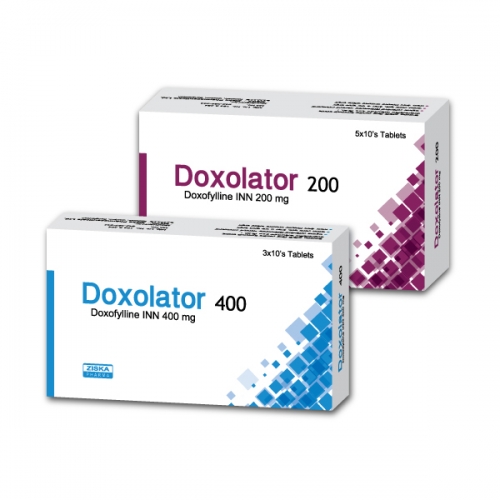ঔষধের বিস্তারিত বা বিকল্প ঔষধ জানতে ঔষধের নাম দিয়ে সার্চ দিন। যেমন- Napa বা Alatrol বা Amodis
Doxolator 400mg
TabletDoxophylline
Ziska Pharmaceuticals Limited
Other Strength:
- Doxolator 200mg
Alternative:
- Fixolin 400mg
- Dophylin 400mg
- Brezofil 400mg
- Flindof™ 400mg
- Clarence 400mg
- Doxofyl 400mg
- Doxofyl SR 400mg
- Doximar 400mg
- Pulmodox 400mg
- Docopa 400mg
- Phydox 400mg
- Pulmino 400mg

Doxolator
Presentation
Doxolator 200 mg Tablet: Each film coated tablet contains Doxofylline INN 200 mg. Doxolator 400 mg Tablet: Each film coated tablet contains Doxofylline INN 400 mg. Doxolator Syrup: Each 5ml syrup contains Doxofylline INN 100 mg.
Description
Doxofylline is a novel bronchodilator xanthine that differs from theophylline for the presence of a dioxolane group in position 7. Like theophylline, doxofylline's mechanism of action is related to the inhibition of phosphodiesterase activities. Moreover, doxofylline appears to have decreased affinities toward adenosine A1 and A2 receptors which may account for the better safety profile of the drug. Doxofylline also inhibits platelet activating factor and the generation of leukotrienes.
Indications
Doxolator (Doxofylline) is used to treat asthma, COPD & bronchospasm.
Dosage & Administration
Adult: 400 mg (1 tablet) daily in the evening. However, in certain cases, 400 mg twice daily is recommended on the basis of the clinical response. Doses as high as 1200 mg/day (400 mg 3 times daily) may also be prescribed. In elderly patients with concomitant cardiovascular, hepatic and renal diseases recommended dosage should be 200 mg twice daily.
Side Effects
After xanthine administration, nausea, vomiting, abdominal pain, epigastric distress, insomnia, headache, nervousness and dizziness may occur. Adverse cardiovascular effects include tachycardia, extrasystoles and palpitation, albuminuria and hyperglycemia may also occur.
Precautions
Xanthine clearance may be altered by different variables affecting its half-life (t ). In patients with cardiovascular failure, renal or hepatic dysfunction, in those with COPD, in patients undergoing influenza immunization or who have an active influenza infection and in patients taking other drugs (eg. cimetidine, allopurinol, propranolol, erythromycin, troleandomycin, lincomycin and ciprofloxacin) clearance may be decreased and its t increase. The dose of doxofylline may be reduced in these conditions. In patients who are taking phenytoin and other anticonvulsants and in those who are smoking, clearance may be increased and its t decreased. In these cases, a higher dose of doxofylline may be required. Caution in patients with the following conditions: Peptic ulcer, hyperthyroidism, hypoxemia, renal or hepatic dysfunction, cardiovascular disorders including arrhythmias, angina pectoris, acute myocardial injury or hypertension and convulsive disorder.
Use in Pregnancy & Lactation
The safe use of doxofylline during pregnancy has not been established. Doxofylline should be used in pregnancy only if the potential benefit justifies the potential risk to the fetus.
এই পাতাটি ১৪৬ বার দেখা হয়েছে
রাজডক কী?
ফ্রী সদস্য হোন Click Here
ডাক্তার হিসাবে যোগদান করতে Click Here
নার্স / টেকনোলজিস্ট হিসাবে যোগদান করতে Click Here
ফ্রী সদস্য হোন Click Here
ডাক্তার হিসাবে যোগদান করতে Click Here
নার্স / টেকনোলজিস্ট হিসাবে যোগদান করতে Click Here

